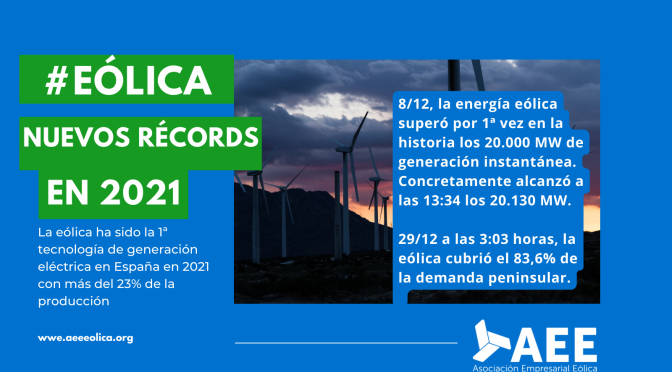Wind energy, the first electricity generation technology in Spain with more than 23% of production
The main source of electricity generation in Spain is wind energy with more than 23% of total production in 2021 (in 2020 it reached 21.9% and in 2019 it was 20.8%).
The wind power installed in Spain is over 28,000 MW. In our country, wind energy is present in practically all the autonomous communities, except Madrid, Ceuta and Melilla.
Spain has more than 1,260 wind farms and 250 industrial centers, employing more than 27,600 professionals and with a contribution to the Spanish GDP in 2020 of 3,106.4 million euros.
Wind energy records in 2021
2021 has been a year of important milestones for wind energy in Spain. The most outstanding is that wind power is the main source of electricity generation in Spain. The closing figures for 2021 highlight that wind technology has registered more than 23% of the total production in our country, thus leading the national generation mix. Furthermore, wind power is also the technology in the Spanish energy system with the highest installed power (28,073 MW, provisional data from REE).
The set of renewables has achieved its best record, producing in 2021 more than 46% of all electricity in our country, almost 10% more than last year.
Two new records reached by wind power in 2021:
On December 8, wind energy surpassed 20,000 MW of instantaneous generation for the first time in history. Specifically, it reached 20,130 MW at 1:34 p.m.
On December 29 at 3:03 a.m., wind power covered 83.6% of the peninsular demand.Wind power in Spain and in the world
The autonomous communities with the highest installed wind power in Spain are Castilla y León, Aragón and Castilla La Mancha.
Spain is the second European country for installed wind power after Germany, and the fifth country in the world after China, the United States, Germany and India.
Key player in the Spanish energy sector
The wind sector is key to meeting the objectives of the PNIEC and reaching 42% of energy consumption from renewables by 2030 and a fundamental pillar for the Energy Transition. In Spain, with more than 1,260 wind farms and 250 industrial centers in Spain, it employs more than 27,600 professionals, contributing to the Spanish GDP with 3,106.4 million euros, which is equivalent to 0.30% (data from the Macroeconomic Study of the Wind Sector of AEE 2020).
Two renewables auctions were held in 2021, specifically in January and October, with the total of the new power auctioned for wind power being 3,256 megawatts. Wind power was the technology that was awarded the most power in these auctions, with average prices respectively of € 25.31 / MWh and € 30.18 / MWh.
With these new megawatts, native and emission-free electricity will be generated for 2.5 million homes, and the current renewable generation will be increased by 8.2%, in addition to the fact that the projects awarded to wind power will involve an investment of more than 2.5 billion of euros.
Key advance in the development of offshore wind power in Spain
Offshore wind power is an opportunity to position the Spanish industry as an international benchmark. In this area, and specifically in floating technology, Spain is a technological and industrial hub worldwide. Thus, it is essential to comply with the Roadmap for the Development of offshore wind and marine energy, approved at the end of 2021, which must be followed by the approval of the maritime spatial planning, the urgent update of the existing regulation for the development of offshore wind projects and the establishment of an auction calendar for floating offshore wind farms.
A sustainable and clean energy on the way to the Energy Transition
Wind power is the technology that has most increased its contribution of clean energy, avoiding the emission into the atmosphere of more than 28.5 million tons of CO2. Thanks mainly to the increase in wind generation, the CO2 emissions of the peninsular Spanish electricity sector reached a new historical low, standing at 46.8% below the emissions of 1990. Electricity was cleaner than ever with an average content of 138 grCO2 / kWh compared to 400 grCO2 / KWh in 1990 and 285 grCO2 / kWh.


